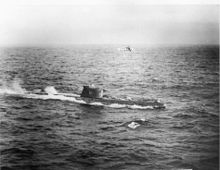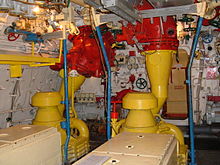Project 641
|
A Libyan Project 641 boat
|
||||||||||||||
|
||||||||||||||
|
||||||||||||||
|
||||||||||||||
|
||||||||||||||
|
||||||||||||||
Project 641 was the name of a class of Soviet diesel-electric submarines . It was called the Foxtrot class by the NATO . It was considered to be particularly reliable and the Soviet Union also sold it to several other countries.
development
Project 641 followed classes Project 611 and Project 633 . In the planning of Project 641, the propulsion system, hull shape, the distribution of torpedo armament and other features of the previous classes were largely adopted; some of the known vulnerabilities have been fixed. By lengthening and widening the hull, more fuel and supplies could be carried and the seafarers had more space on the submarine. The construction diving depth was increased to 250 meters and preparations were made for the use of modern torpedo and sea mine types .
hull
The shape of the fuselage was based heavily on Project 611. Both projects shared a comparable propulsion system with three shafts , so the use of a similar hull shape was obvious. In project 641, the drag was reduced by relocating the sonar sensor from the underside of the hull to the bow tip. The flow behavior was improved by a different curvature of the ship's sides, so that the speed of Project 641 hardly changed compared to its predecessor despite the greater displacement .
Machine systems
During surface travel and snorkeling , the submarines were powered by the standard marine diesel engine of Soviet submarines. The configuration was identical to that on Project 611: three 37D engines with 2,000 hp (1,471 kW) each. The maximum speed was 16.8 knots.
When underwater, the boats were powered by electric motors, which obtained their energy from lead-acid batteries. Two PG-101 motors with 1,350 PS (993 kW) each drove the two outer shafts , the middle one was driven by a PG-102 electric motor with 2,700 PS (1,986 kW). A PG-104 electric motor with 140 PS (103 kW) was available for crawling , which acted on the middle shaft. The PG-104 consumed a lot less energy than the PG-102 motors and was much quieter.
Range
At 8.13 knots cruising speed, the boats of Project 641 could cover 30,000 nautical miles on one tank of fuel. Submerged, the battery capacity was enough for 16 nautical miles at 15.30 knots. The supplies on board enabled deployments of up to 90 days.
Armament
Project 641 received six bow and four stern torpedo tubes in caliber 533 mm. A similar combination had already been used in Project 633, but only with two stern torpedo tubes. 22 torpedoes or alternatively 32 MDT sea mines could be carried. 18 of these torpedoes could be stored in the bow torpedo room and four in the stern room.
The range of torpedoes that could be used was very broad and extended from old models such as the 53-39 from World War II to the 53-51 from 1951, to the 53-65M and 53-65K torpedo types developed in the late 1960s. The torpedoes of the 65 series were already very fast with a top speed of almost 70 knots, had automatic guidance, a proximity fuse and could be set down from a depth of 150 meters. However, they were only suitable for attacking targets on the water surface and could not be used against enemy submarines. It was also possible to use 533 mm torpedo models with a nuclear warhead .
Project 641 submarines built in the 1970s and 1980s for export to India were given other 400 mm stern torpedo tubes.
Sensors

Project 641 was equipped with an "Arktika-M" sonar system. You could use active and passive sonar systems. An "MG-10" or "MG-15" system for acoustic underwater telephony was installed next to the sonar system in the bow. A “Nakat” ESM system, a “flag” radar and several radio antennas could be deployed on the surface .
units
After the completion of 62 boats, the construction of Project 641 for the Soviet Navy was stopped in 1967. The last four of these boats were exported. From 1972 to 1983, 13 more boats were built for export, six for Libya , four for India and three for Cuba .
A selection:
B-29
The boat was laid down in Leningrad on March 25, 1966. It was launched on May 20th of that year and was assigned to the Northern Fleet. In the following years, the B-29 was mainly used in the Mediterranean Sea and patrolled the region, including during the Yom Kippur War in October 1973. After an overhaul, it was handed over to the Polish Navy in 1988 and served there as Dzik with the registration number 293. It was retired and scrapped in 2003.
B-33
B-33 was laid down in Leningrad on February 3, 1961 and was launched on April 27 of that year. In 1962 it was assigned to the Pacific Fleet . On February 18, 1987, a cable fire occurred in a switchboard in the second department while diving at periscope depth . The fire spread to paneling made of wood and efforts to extinguish the fire were unsuccessful, so that division two was evacuated. The fire burned for over an hour and the commander finally flooded the torpedo room (Section 1) in order to prevent the weapons stored there from exploding. Five seamen died and another 15 suffered smoke inhalation . The boat has been repaired. In 1991 a sailor opened the inner closure of a torpedo tube, although it was open to the sea. B-33 sank in the harbor basin. It was lifted and later scrapped.
B-37
B-37 was laid down in Leningrad on July 18, 1958 and launched on November 5, 1958. It was assigned to the Northern Fleet and stationed at Polyarny .
On January 11, 1962, a fire broke out on board during maintenance work in the port. Eleven torpedoes exploded in the bow torpedo room. The boat sank and 59 crew members died. In 1963 the wreck was scrapped.
B-59

The boat was laid down in Leningrad on February 21, 1960 and launched on June 6 of the same year. It was assigned to the Northern Fleet and stationed in Polyarny. On September 21, 1962, it set out for Cuba together with three other submarines. On October 20, 1962, at the height of the Cuban Missile Crisis , the B-59 reached the quarantine zone that the US Navy had established around the island. B-59 attempted to resume its voyage submerged, but was discovered and pursued non-stop by American anti-submarine ships, aircraft and helicopters. B-59 could not send or receive any radio transmissions while submerged, so that the crew neither had information about the overall situation nor was able to inquire. As US ships finally safe, but still clearly perceptible distance from the boat water bombs threw off were many sailors of B-59, attacked based on the information about the tense situation before the dive, convinced they would and now the Third World War had broken out . As the submarine's diving time was coming to an end because the batteries had to be recharged on the surface, the commander decided to have a torpedo with a nuclear warhead ready for use. With the intervention of Vasily Alexandrovich Archipov and other seamen, the weapon was never used and the war, which the crew believed had already broken out, was prevented. B-59 surfaced and returned to the Soviet Union a month later. After operations in the Atlantic and the Mediterranean, B-59 was decommissioned in Sevastopol in 1990 and scrapped in 1992.
B-98
The boat was laid down on April 4, 1963 and launched on June 15 of that year. It was assigned to the Soviet Northern Fleet. From 1968 to 1970 the boat made a trip to Vladivostok with stops in Kenya , Somalia and Equatorial Guinea . On November 3, 1987, the boat was handed over to the Polish Navy , where it served as the 292 Wilk until it was retired in 2001.
B-101
B-101 was laid down in Leningrad on June 19, 1963 and launched on August 30, 1963. In 1964 it was subordinated to the 182nd Flotilla of the Pacific Fleet. In 1982 it was turned off for the measurement of gravimetric fields as part of a research contract from the Soviet Academy of Sciences under the name “Regulus” (Russian: “Регул”) . During the mission, which lasted until mid-1983, the B-89 covered almost 25,000 nautical miles. In 1991 the boat was taken out of active service, in 1993 it was removed from the fleet list and scheduled for scrapping. In 1996 the abandoned wreck capsized at its anchorage.
S-20
S-20 was laid down under the registration number B-420 in Leningrad on December 25, 1968 and launched on February 25, 1969. The boat was renamed S-20 and moved in 1970 through the Baltic Sea via Spain and Mauritius to the Indian naval base Visakhapatnam . The boat was stationed in Bombay during the conflict with Pakistan . After the outbreak of the Bangladesh War , it was used from November to December 1971 to monitor the shipping routes to Karachi . The boat was decommissioned in 2001 and set up as a museum ship on a beach in its former home port in 2002.
Evidence and references
Remarks
- ↑ B-143 is mentioned as the caption and on the museum pages. However, according to Russian sources, the boat on display in Zeebrugge is B-821.
Individual evidence
- ↑ a b c to AB Shirokorad : Soviet post-war submarine structures. P. 68 and J. Apalkow: Корабли ВМФ СССР. Многоцелевые ПЛ и ПЛ спецназначания. P. 41.
- ↑ a b A.B. Shirokorad: Soviet post-war submarine structures. P. 68.
- ↑ a b J. Apalkow: Корабли ВМФ СССР. Многоцелевые ПЛ и ПЛ спецназначания. P. 41.
- ^ Norman Friedman: The Naval Institute guide to world naval weapon systems. P. 732.
- ↑ a b Project 641 on deepstorm.ru, viewed on July 17, 2011
- ↑ Former page Seafront Museum Zeebrugge, viewed on July 23, 2011 ( Memento from February 6, 2010 in the Internet Archive )
- ↑ B-143 at deepstorm.ru, viewed July 23, 2011
- ^ AB Shirokorad: Soviet post-war submarine structures. P. 64.
literature
- А.Б. Широкорад: Советские подводные лодки послевоенной постройки (AB Shirokorad: Soviet U-Boat Post-War Buildings . ) Moscow 1997, ISBN 5-85139-019-0 (Russian).
- J. Apalkow: Корабли ВМФ СССР. Многоцелевые ПЛ и ПЛ спецназначания. (For example: Ships of the USSR - multipurpose submarines and special submarines. ), Saint Petersburg 2003, ISBN 5-8172-0069-4 (Russian).
- Norman Friedman: The Naval Institute guide to world naval weapon systems. 5th edition, US Naval Institute Press, 2006, ISBN 978-1-55750-262-9 (English).
- Jeffrey Tall: Submarines and Deep Sea Vehicles. Neuer Kaiser Verlag, 2002, ISBN 3-7043-9016-X .
Web links
- Project 641 at deepstorm.ru (Russian)




